Wine has played a significant role in the fabric of ancient societies, binding together the tapestry of culture, economics, and religion. In the Mediterranean, it was elevated beyond a mere beverage to become a symbol of civilization and a staple of daily life.
The journey of wine began millennia ago, with its origins tracing back to the earliest agricultural societies. The cultivation of wild grapevines was a significant step in human advancement, setting the stage for a rich history intertwined with the growth of empires and the evolution of communities.
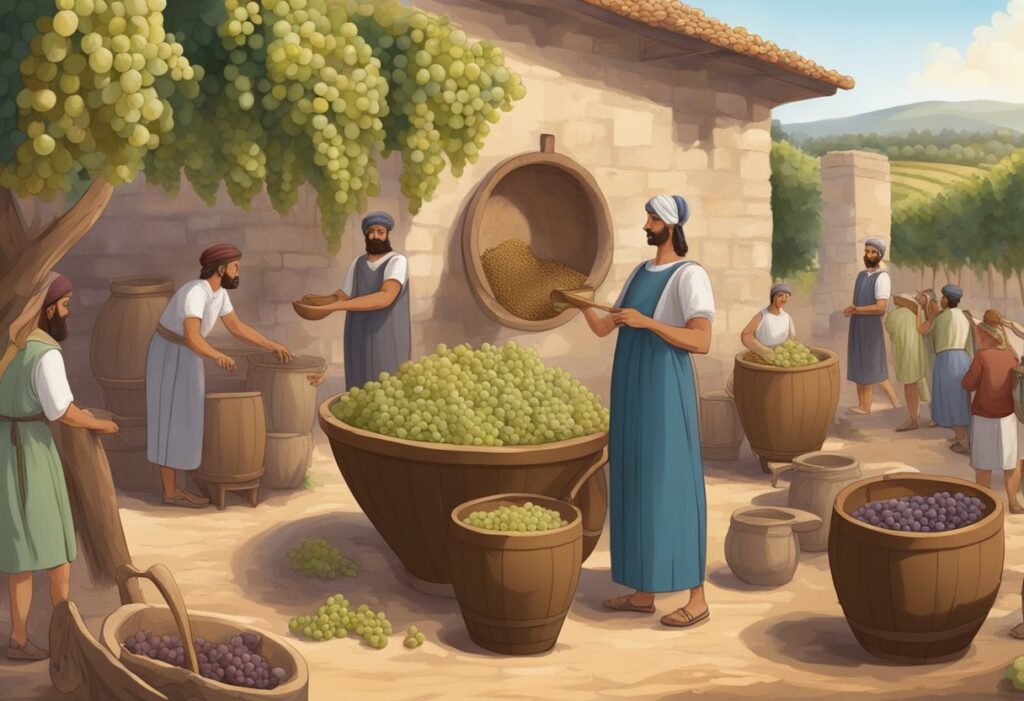
As viticulture spread across the Mediterranean, it shaped and was shaped by the cultures it encountered. Whether it was the Greeks who extolled its virtues in philosophy and celebration or the Romans who brought organization and scale to its production and distribution, wine became an irreplaceable commodity.
It is through the diligent study of archaeological findings, such as ancient amphorae and the remnants of old vineyards, that we have come to understand the sophisticated methods of wine production and preservation that our ancestors developed.
These practices and the social structures around them laid down a legacy that impacts modern winemaking to this day.
Key Takeaways
- Wine was central to the daily and ceremonial life in ancient Mediterranean cultures.
- Advances in viticulture and trade significantly shaped the ancient economy and society.
- The legacy of ancient winemaking techniques continues to influence modern practices.
Origins and Early Development
Wine’s history is as rich and intricate as its flavors, dating back to the dawn of civilization. Your understanding of wine’s heritage begins with its Neolithic roots and extends through the advancements made in ancient Egypt.
Discovery of Winemaking in Neolithic Period
Neolithic period finds are pivotal, illuminating early wine production’s background. The earliest archeological traces of winemaking date back to 7000 BC in ancient China, where residues of a fermented concoction of grapes and rice were discovered.
This predates the discovery of vitis vinifera, the primary grape variety used in modern winemaking, which was found over 8,000 years ago in the Caucasus. The art of winemaking further blossomed in western Asia, notably in the site called Hajji Firuz, Iran, where remnants within amphorae dating back to 5400-5000 BCE revealed a mixture of tannin and tartrate crystals, telltale signs of early wine production techniques.
Advancements in Ancient Egypt
Transitioning from the Neolithic era, ancient Egypt became a nexus for winemaking advancements. Egyptian civilization harnessed the fertile Nile valley, scaling up grape cultivation and fermentation processes.
Pottery shards inscribed with vineyard names indicate that wine was not only produced but also an organized, commercial endeavor. Egyptians innovated with wine storage, improving the longevity and transportability of wine, which contributed to its proliferation within their society and trade with neighboring regions.
These contributions cemented wine’s place as both a ceremonial libation and a daily pleasure, woven deeply into the societal fabric.
Spread of Winemaking in the Mediterranean
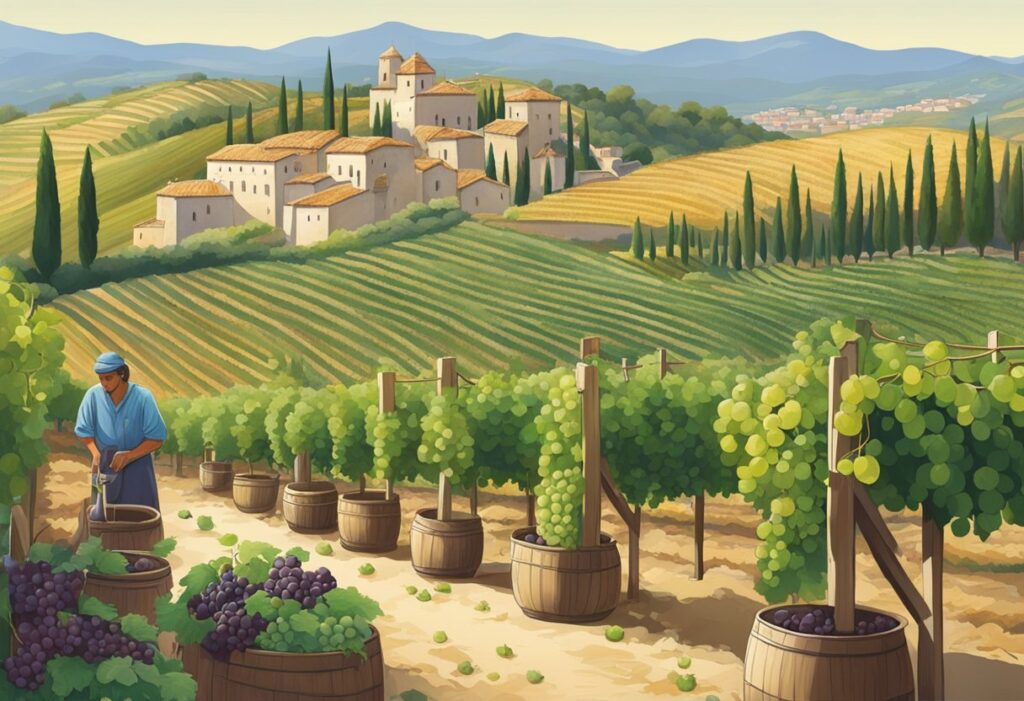
As you explore the history of winemaking in the Mediterranean region, you’ll encounter the influential roles of the Phoenicians, Greeks, and Romans, who each advanced viticulture practices and spread the cultivation of vines across various territories.
Phoenician Contribution to Viniculture
The Phoenicians played a pivotal role in spreading viticulture across the Mediterranean. They transported vines and winemaking expertise to their widespread trading outposts, which included major hubs in Sicily, Spain, and North Africa.
Their extensive maritime trade networks facilitated the integration of winemaking into local economies and cultures. You can appreciate the scope of their impact at the World History Encyclopedia.
Grecian Vines and Dionysus Cult
In Greece, wine became deeply intertwined with the fabric of society, bolstered by the cult of Dionysus, the god of wine and festivity. The rituals and festivals in his honor ensured that viticulture was a significant part of Grecian culture.
The Greeks’ influence is seen in the spread of vine cultivation throughout their colonies and in their contributions to wine-related literature and theater. The Greeks imparted their knowledge of the vine across the Mediterranean, leaving a lasting legacy in their wake.
Roman Viticulture and Expansion
The Romans advanced viticulture to new heights, perfecting cultivation techniques and creating large-scale wine production. Their organization of vast vineyards, notably in regions of Italy like Tuscany and Campania, set the foundation for modern winemaking practices.
Roman trade routes and the expansion of their empire fostered the spread of viticulture into regions such as Gaul and the Germanic provinces, which later became renowned for their wine production. Exceptional details on Roman innovations can be found through this University of Chicago article.
Wine in Various Ancient Cultures
Wine has had a profound impact on various ancient societies, playing a key role not only as a staple drink but also in religious rituals, economic trade, and social settings.
Greek and Roman Cultural Impact
The ancient Greeks are recognized as pivotal in the history of wine, developing sophisticated methods of viticulture and wine production. Your understanding of Western wine culture is greatly indebted to the Greek’s innovations, which included the cultivation of diverse grape varieties and the use of amphorae for storage and transportation.
This knowledge, paired with their practices and the cultural significance of wine, was conveyed to other regions through extensive trade and colonization efforts.
Similarly, the Romans furthered the art of winemaking. From setting the foundations of modern viticulture to establishing the first appellation systems, their contribution to wine culture was substantial.
They emphasized the importance of terroir — the idea that the same grape variety could produce different wines depending on where it was grown. You might find it fascinating that they also documented detailed winemaking techniques which have influenced how wine is produced even today.
Far Reach to China and Persia
Wine’s influence reached far beyond the Mediterranean. In China, wine made from grapes was introduced as a result of the Silk Road trade and quickly assimilated into their culture. The Greeks and Romans may not have directly introduced wine to China, but the trade routes established by their empires facilitated its arrival and the exchange of winemaking techniques.
Persia (now Iran) had a rich history of wine production, with Shiraz being well-known for its wine-making heritage. While not directly influenced by Greek viticulture, the Persians developed their own traditions and styles of wine. However, the spread of the Greek influence across Asia Minor and into Persia under Alexander the Great’s expeditions had indirect effects on local wine production, encouraging cultural exchange between the two regions.
Technological Advancements in Winemaking
To understand the progress of winemaking, it’s essential to examine the pivotal technological strides in grape cultivation and the design of the wine press over the centuries.
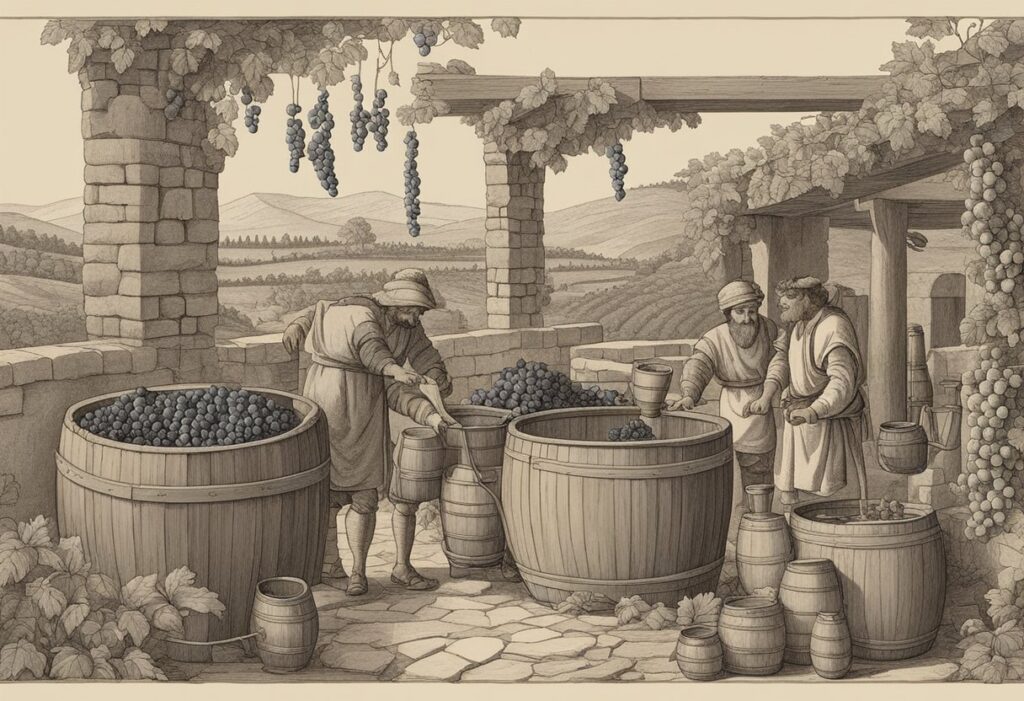
Innovations in Grape Cultivation
Advances in viticulture have significantly altered how grapes are cultivated for winemaking. One of the key developments was the methodical selection of grape varieties best suited to specific climates and soils, which improved the quality of the wine. This scientific approach to selecting and breeding grapevines allowed for consistent and desirable characteristics in wine, enhancing both flavor and resistance to disease.
Evolution of the Wine Press
The wine press is a critical technology that has shaped winemaking. Initially, grapes were likely crushed by foot, a method that can still be seen in traditional processes today. As time progressed, the Roman screw press emerged, representing a substantial leap in efficiency and consistency in extracting juice from grapes.
This ancient innovation continued to evolve, becoming more sophisticated with improvements in materials and mechanics, leading to the variety of presses used in modern winemaking.
Discover ancient wine production techniques that illuminate the origins of the technology you’re using today. The journey from simple foot treading to the development of the mechanical press reflects a continuous pursuit to refine the winemaker’s art.
Religious and Social Roles of Wine
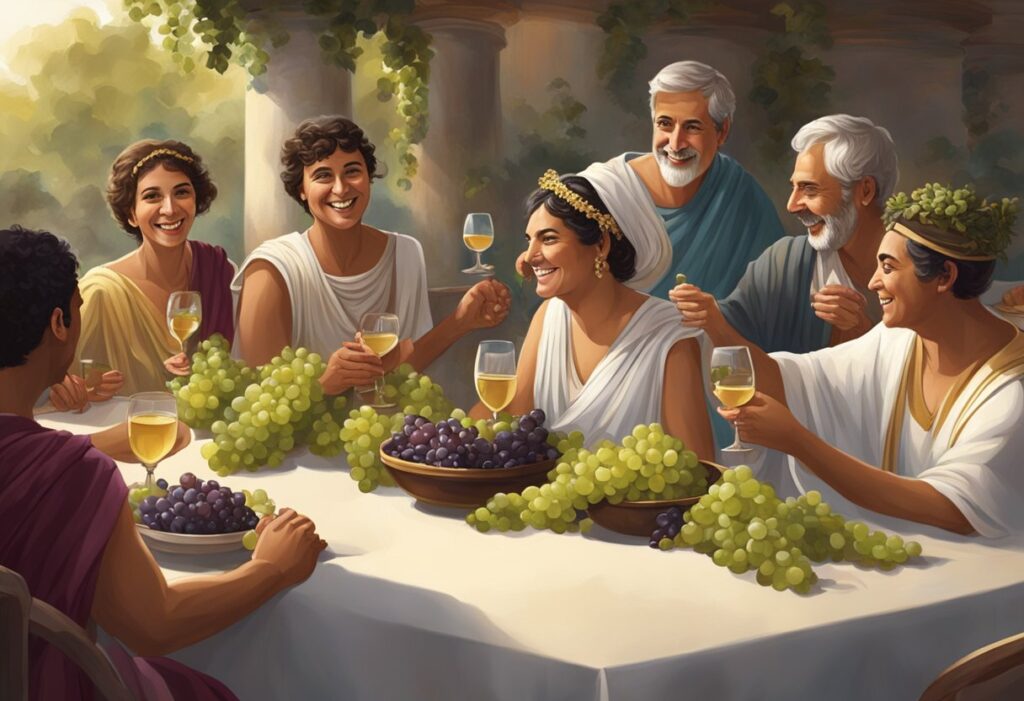
Wine has held a pivotal role in both the religious ceremonies and social frameworks of ancient civilizations, from sacred rituals to social lubrication, marking its integral presence throughout history.
Wine in Ancient Religious Rituals
In the realms of religious practices, wine has been a symbol of the divine. The Eucharist, a central rite in Christian tradition, uses wine to represent the blood of Jesus, reflecting the narrative of the Last Supper. This practice has roots in biblical references where wine is frequently mentioned.
Additionally, the Greeks celebrated Dionysus, the god of wine, integrating the beverage into various religious festivals. These celebrations often involved the partaking of wine to honor the deity and encourage revelry among participants.
The ancient Egyptians, stretching back to 4,000 BCE, linked wine with several deities, turning it into an offering to gods such as Hathor. This serves as an early evidence of wine’s religious significance, emphasizing its sanctity in ritualistic contexts.
Social Significance Across Civilizations
Wine’s role in social spheres was equally substantial. In Greece, it was not just a drink but a cornerstone of societal interaction, especially in symposia — gatherings where philosophical, political discussions and poetry recitals took place over cups of wine. Similarly, in ancient Rome, wine was a democratic drink enjoyed by all strata of society at public feasts and gladiatorial games.
Across the Mediterranean, the culture of viticulture and wine consumption spread through Roman colonization, weaving wine into the sociale fabric of the empire. It was omnipresent at banquets and became synonymous with hospitality and the art of living well.
These customs underscore the history of wine as not just an agricultural product but as a vital contributor to building and nurturing communal bonds in both Greece and Rome, reflecting evidence of its deep integration into the social and religious life of these civilizations.
Ancient Wine Trade and Economy
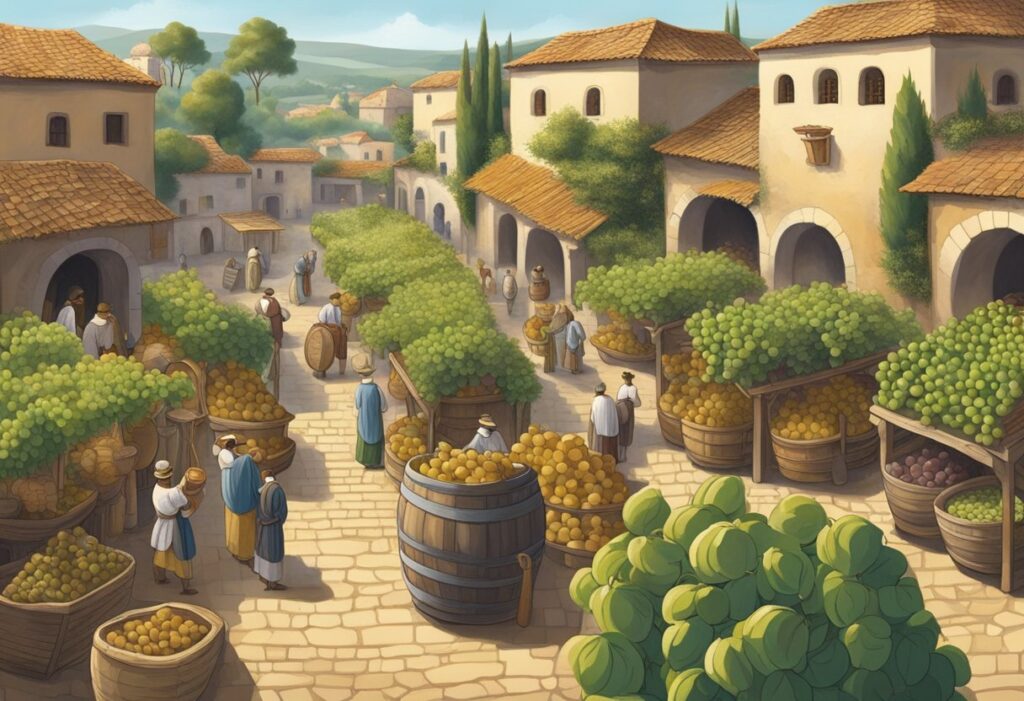
In antiquity, the wine trade was a significant driver of the Mediterranean economy, deeply influencing the cultures and societies from ancient Greece to Rome.
Amphorae and Ancient Wine Shipping
Amphorae were the quintessential containers for shipping wine across the Mediterranean. Their distinct shape—with two handles and a narrow neck—was designed for ease of storage and to prevent spillage.
Different regions had specific amphorae designs, with stamps indicating origin, wine producer, or quality, much like a modern label. These vessels have been found throughout ancient sites, showcasing extensive trading networks stretching from Greece to Gaul and Crete.
Significance of Wine in Ancient Economies
Wine was more than just a beverage in ancient societies; it was a crucial economic commodity. Ancient Greeks and Romans, for instance, regarded wine production as an art, a science, and a business. Wine’s significance was twofold: it was consumed daily by a wide range of social classes, and it was a key traded good.
Trade routes for wine were established throughout the Mediterranean, linking various civilizations. The economies of regions like Crete flourished in part due to their role in viticulture and wine trading, helping to sustain entire communities and industries.
Preservation and Storage Methods in Antiquity
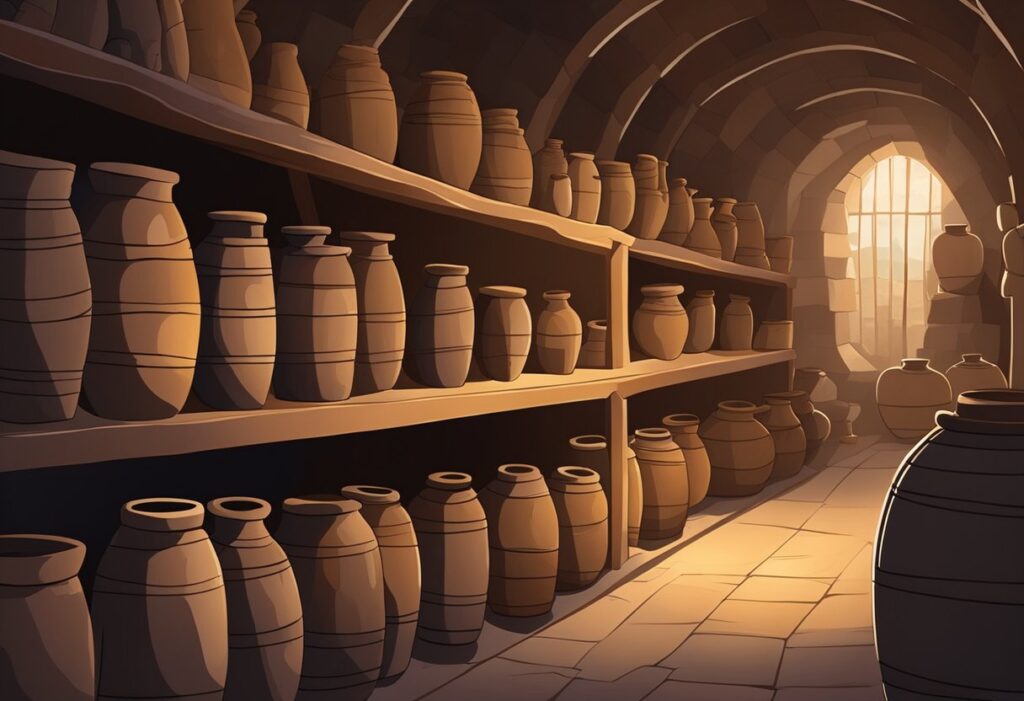
The ancient approaches to preserving and storing wine played a crucial role in maintaining its quality and flavor over time. Techniques involving various materials were essential to the integrity and longevity of this cherished beverage.
Use of Resin and Honey in Wine
In antiquity, winemakers often used resin to preserve wine, enhancing its shelf life. This practice involved adding pine resin to wine, which had antiseptic properties to prevent spoilage. Similarly, honey was sometimes added to wine, not only as a sweetener but also for its preservative qualities, helping wine to resist oxidation and deterioration.
Evolution of Wine Storage Jars
The design and materials of wine storage jars underwent significant evolution in ancient times. The Bronze Age saw the standardization of clay containers known as amphorae, which were pivotal for the transport and storage of wine.
These jars typically had two handles and a narrow neck, which minimized wine’s exposure to air and facilitated easier sealing and carrying. The shape and make of these jars were perfectly suited for holding liquid contents like wine and effectively protected the stored wine from the environment.
Archaeological Findings and Chemical Evidence
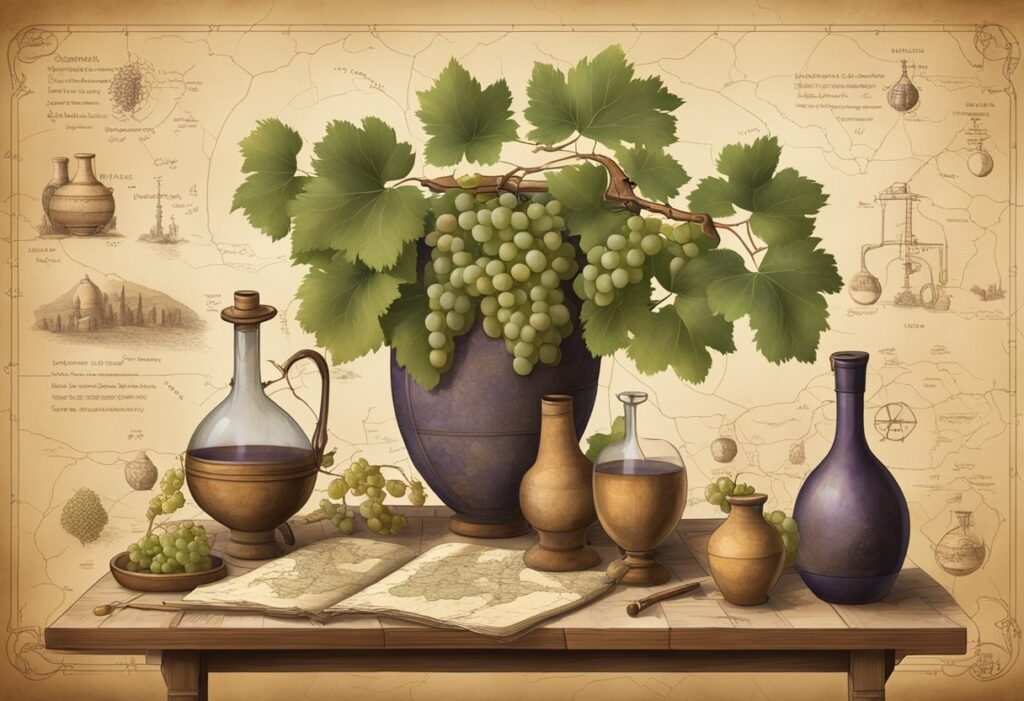
This section delves into the significant discoveries and analyses that reveal the ancient practice of winemaking, demonstrating its deep roots in human history.
Discovery of Ancient Wineries
Archaeological investigations have uncovered physical structures and artifacts suggestive of ancient winemaking facilities across the Mediterranean. You can find evidence ranging from remains of grapes and vines to tools and winepresses. In the cradle of Western civilization, the ancient Greeks utilized various technological innovations for viticulture that reflect a sophisticated understanding of winemaking.
Notable Finds in Areni-1 Cave
The Areni-1 cave complex in Armenia is a site of unparalleled importance. Archaeologists discovered installations dating back to 4000 BCE that are indicative of wine production. This cave is key in understanding the evolution of winemaking, offering a glimpse into how ancient societies may have celebrated and utilized wine.
Chemical Analysis of Ancient Wine Residues
The chemical evidence of ancient wine residues provides the strongest testimony to early wine production. Through advanced analysis techniques, researchers can detect specific compounds such as tartaric acid and anthocyanins, which are hallmarks of grape wine.
These findings reinforce the archaeological evidence and paint a vivid picture of the antiquity of winemaking practices. For instance, the testing of residues within vessels can trace the composition of wine, contextualizing how it was produced, traded, and consumed in antiquity.
Legacy and Influence on Modern Winemaking
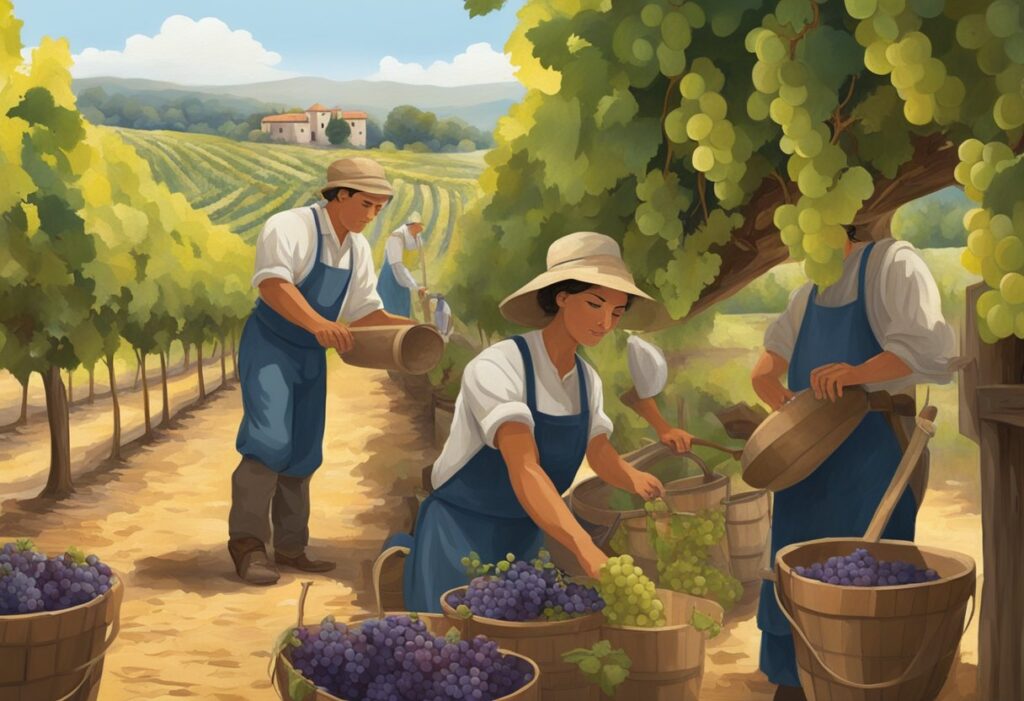
The wines of antiquity have cast a long shadow, influencing not merely the flavors but the very techniques that define today’s winemaking traditions.
From Ancient Times to the Modern Vineyard
Ancient winemaking methods continue to shape modern viticulture. In France, the home of the aromatic Gewurztraminer, winemakers employ time-honored practices, like those seen in the amphora-aged wine of Greece and Italy‘s storied viticulture.
In Europe‘s esteemed vineyards, some methods that originated in antiquity persist, evoking the historical depth of the history of wine.
In regions such as Italy, the ancient Roman impact on structured grape cultivation and regional appellation controls set a precedent. As a result, Italian wines, recognized globally for their quality, echo historical influence – from the Tuscan hills to the sunbathed slopes of Sicily.
The flourishing wine industry in Spain also nods to the past. Spanish wines still reflect the varietal diversity and blending techniques developed throughout history. With wines known for their robust flavors and mature character, contemporary winemakers in Spain revere the historical practices passed down through generations.
The enduring techniques of winemaking, like the gentle crushing of grapes or vinification in clay vessels, also come from a lineage reaching back to early wine crafters. Modern-day vintners may integrate ancient approaches with cutting-edge technology to create wines that balance traditional authenticity with modern preferences.

